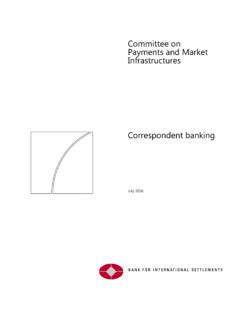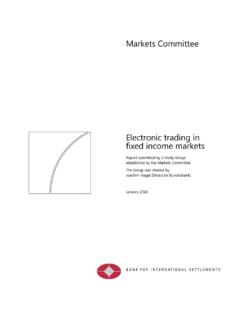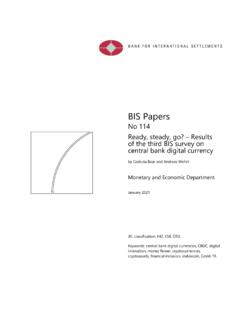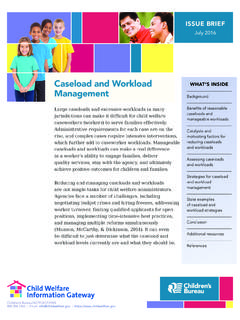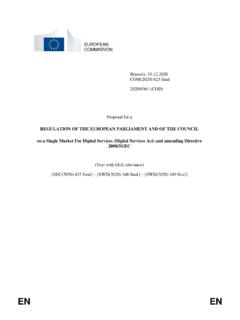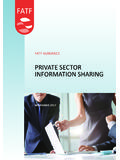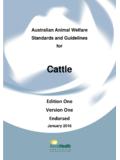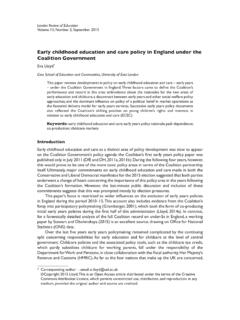Transcription of Basel Committee on Banking Supervision Consultative …
1 Basel Committee on Banking Supervision Consultative Document Fundamental review of the trading book: A revised market risk framework Issued for comment by 31 January 2014 October 2013 This publication is available on the BIS website ( ). Bank for International Settlements 2013. All rights reserved. Brief excerpts may be reproduced or translated provided the source is stated. ISBN 92-9131-971-6 (print) ISBN 92-9197-971-6 (online) Fundamental review of the trading book: A revised market risk framework iii Contents Executive summary.
2 1 Section 1: Overall revisions to the market risk framework .. 7 The trading book/ Banking book boundary .. 7 Treatment of credit .. 10 Factoring in market liquidity .. 13 Choice of market risk metric and calibration to stress conditions .. 18 Treatment of hedging and 19 Relationship between the standardised and internal model-based approaches .. 21 Section 2: Revised models-based approach .. 23 The overall approach to internal models-based measurement .. 23 The identification of eligible trading desks.
3 25 Section 3: Revised standardised approach .. 31 Objectives and rationale for a revised standardised approach .. 31 General features of the revised standardised approach .. 32 Calibration of the revised standardised 34 Proposed treatments by asset class .. 35 Section 4: Disclosure requirements .. 44 Section 5: Impact 45 Annex 1: Revised market risk framework .. 46 Annex 2: Actions to reduce variation in risk-weighted assets for market risk .. 116 Fundamental review of the trading book: A revised market risk framework 1 Fundamental review of the trading book: A revised market risk framework Executive summary This is the Basel Committee s ( the Committee )1 second Consultative paper on the fundamental review of trading book capital The revisions to the capital framework set out in this paper aim to contribute to a more resilient Banking sector by strengthening capital standards for market risks.
4 They form part of the Committee s broader agenda to reform regulatory standards for banks in response to the financial crisis. The revisions in this paper also reflect the Committee s increased focus on achieving a regulatory framework that can be implemented consistently by supervisors across jurisdictions. As such, they incorporate the lessons learned from the Committee s recent investigations into the variability of market risk-weighted Background The financial crisis exposed material weaknesses in the overall design of the framework for capitalising trading activities.
5 The level of capital required against trading book exposures proved insufficient to absorb losses. As an important response to the crisis, the Committee introduced a set of revisions to the market risk framework in July 2009 (part of the Basel package of reforms). At the time, the Committee recognised that the Basel revisions did not fully address the shortcomings of the framework. In response, the Committee initiated a fundamental review of the trading book regime, beginning with an assessment of what went wrong.
6 The Committee published the first Consultative paper in May 2012. Having reflected on comments received, this paper sets out more detailed proposals for reforming the trading book regime, including draft text for the Basel Accord. Key areas of Committee focus The Committee has focused on the following key areas as part of its review: 1 The Basel Committee on Banking Supervision provides a forum for regular cooperation on Banking supervisory matters. It seeks to promote and to strengthen supervisory and risk management practices globally.
7 The Committee comprises representatives from Argentina, Australia, Belgium, Brazil, Canada, China, France, Germany, Hong Kong SAR, India, Indonesia, Italy, Japan, Korea, Luxembourg, Mexico, the Netherlands, Russia, Saudi Arabia, Singapore, South Africa, Spain, Sweden, Switzerland, Turkey, the United Kingdom and the United States. Observers on the Basel Committee are: the European Banking Authority, the European Central Bank, the European Commission, the Financial Stability Institute and the International Monetary Fund.
8 2 To view the first Consultative paper, see Basel Committee on Banking Supervision , Fundamental review of the trading book, May 2012 ( ). It is intended that this second Consultative paper can be read as a standalone document, without the need for cross reference with the first Consultative paper. 3 See Basel Committee on Banking Supervision , Regulatory consistency assessment programme (RCAP) Analysis of risk-weighted assets for market risk, January 2013 (revised February 2013), 2 Fundamental review of the trading book.
9 A revised market risk framework The trading book/ Banking book boundary The Committee believes that the definition of the regulatory boundary between the trading book and Banking book has been a source of weakness in the design of the current regime. A key determinant of the boundary has been banks self-determined intent to trade. Trading intent has proven to be an inherently subjective criterion that is difficult to police and insufficiently restrictive from a prudential perspective in some jurisdictions.
10 Coupled with large differences in capital requirements against similar types of risk on either side of the boundary, the overall capital framework proved susceptible to arbitrage before and during the crisis. In May 2012, the Committee put forward for consideration two alternative definitions for the boundary: a trading evidence-based approach and a valuation-based approach. Having reflected on feedback from the first Consultative paper, the Committee has developed a revised boundary that retains the link between the regulatory trading book and the set of instruments that banks deem to hold for trading purposes, but seeks to address weaknesses in the boundary by reducing the possibility of arbitrage and by providing more supervisory tools.










